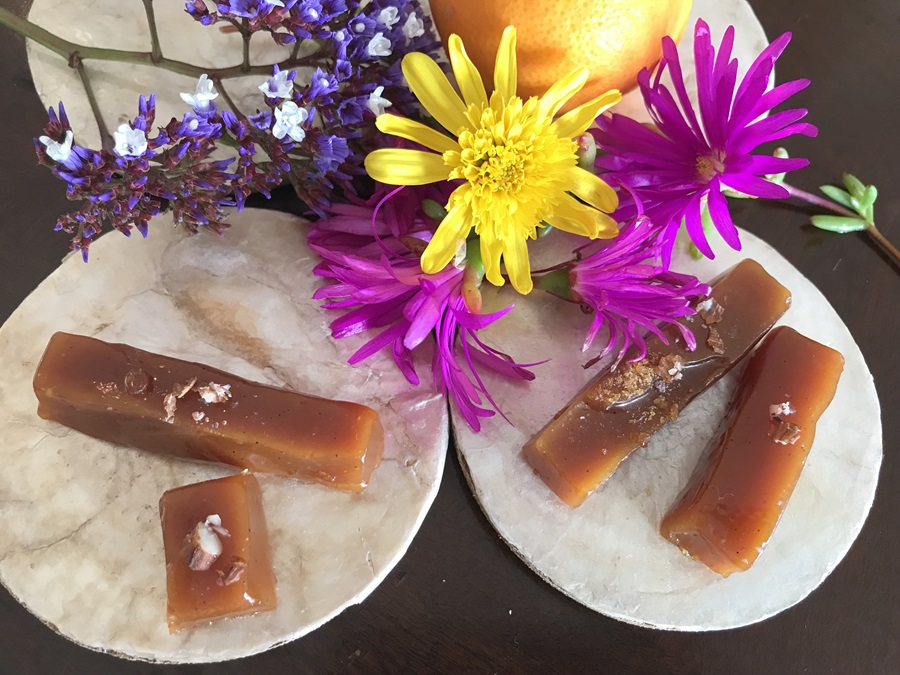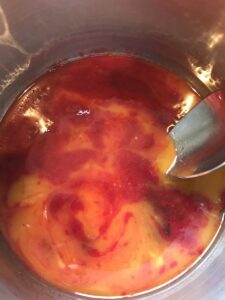Our annual visits to San Diego always involve tacos of every description. With Mexico less than 20 miles away, our meals here also feature extraordinary fruits and full-flavored vegetables from the farmers market and fresh grilled fish and shrimp. But the standouts we love best can be found at a place in the seaside neighborhood where we go to put our feet up and where internet service is thankfully erratic. It’s an unlikely Cuban café called Azúcar, which means sugar.
New tastes and cooking traditions are among my favorite travel souvenirs. And since our family loves to cook, we come back from trips and zealously (if not always successfully) attempt to recreate the best of those flavors. While we haven’t yet found the secret to the savory pastelitos from Azúcar, this year we’ve perfected the passion fruit caramels.

After the usual late-night arrival, it is tempting to go nowhere the first morning. Perched on a patio right above the crashing waves of the Pacific, Hugo and I sip coffee made with our travel cone filter and eat a packet of cookies from the plane.
Thus steadied, we stroll over to Azúcar for the first of our daily visits. A Cubano or two — espresso with a touch of sugar — is just the thing for jet lag. And the only decision is what will accompany it: puff pastry with guava and creamy cheese or the spiced pastelitos de carne?
We’ve frequented this café for 10 years. Daughter Lucy, who discovered it, often walks over from her house several blocks away with her husband, Jason, and our two grandsons to join us. After sampling most of the café’s offerings, including a white chocolate soufflé with passion fruit cream, mango cheesecake with coconut shortbread, and pistachio macarons as big as our hands, we settled years ago on starting the day with the pastelitos stuffed with finely ground beef, onion, a few raisins, and a subtle warm spice.
Securing our regular table outside, Hugo and I both comment on how pleasant it is to find that nothing much has changed since last winter. A cool ocean breeze wafts up Newport Street. Ocean Beach keeps its vintage hippie-surfer-dropout vibe, though it’s now overlooked by ever-more expansive homes on the steep hillsides above. Sometimes one travels for change, but in these strange, tense times, familiarity is a comfort.
I did wonder how an exquisite Cuban café came to grace this famed surfing town so far away from the Caribbean. I looked up the café’s owner-chef, Vivian Hernandez-Jackson, to find out the story — and also hoping to get my hands on her pastelito recipe. Our own efforts to recreate those little meat pies had come close, but even though Lucy, Hugo, and I all put on a few pounds testing various versions, in the end they were still missing something.
The daughter of Cuban immigrants, Vivian grew up in Miami and remembers almost daily visits to the neighborhood bakery there. She had wanted to bake ever since childhood, so, after college, she studied pastry making at the Cordon Bleu in London and then decided to see the American West. She taught at a culinary school in San Diego and worked in marketing and in a café before deciding her neighborhood could really use a from-scratch bakery. The town clearly agreed. “Every year it just gets busier,” she said.
When we met at the café, Vivian, dressed in chef pants and an apron dusted with confectioner’s sugar and flour, told me right off that she would not share the pastelito recipe. It is a family secret, her mother’s recipe, as well as the café’s top seller.
Vivian is an artist with tropical flavors and fresh flowers, and I’ve not tasted better pastries than hers, even in Paris. They are so far beyond my skill level that I never considered trying to recreate them. But there was one other irresistible delicacy I decided to ask her about — the café’s passion fruit caramels seemed within reach. She gave me the recipe to share with readers during the chilly, rainy days of late winter on Cape Cod.

With a unique, pleasing tartness, these caramels leave you craving more. They are embellished with the slightest dusting of something crunchy on top that seems like bitter chocolate but not exactly. Vivian explained that it’s cacao nib dust. But you can’t just grind up some nibs. This “dust” starts with warming sugar in a skillet, then combining it with the bits of dried cacao beans. It’s the hard-caramelized result she crushes for the topping.
As I gathered up my notes I asked one more question about the meat pies, confirming that they are generously brushed with a simple syrup. I told Vivian what my grandson Max, age six and a ravenous pastelito fan, told me: my meat pies are “almost as good as Azúcar’s.” There’s something missing, I said. She smiled. “We use stick cinnamon,” she said.
Vivian assured me, as we shook hands, that the caramels are easy to make. I had never made candy before and didn’t even own a candy thermometer — but an instant-read will do for these, as long as you have a good one that measures to at least the 253° F temperature the caramel needs to reach. The passion fruit purée is available frozen or canned in many markets.
Placed on small squares of parchment or wrapped individually in candy wrappers, they make a lovely gift. Served on a plate on a table festooned with flowers, they take us right back to California by way of Cuba and Florida.
PASSION FRUIT CARAMELS
Fills a 9- to 10-inch square pan
For the caramels
8 oz. frozen passion fruit purée, thawed
2 Tbsp. raspberry purée (1/3 cup frozen raspberries, defrosted and pressed through a sieve to remove seeds)
¼ cup fresh lemon juice
1 oz. vanilla bean paste
1¾ cups sugar
¼ cup light corn syrup
¾ cup heavy cream
6 Tbsp. unsalted butter
For the cacao nib“dust”
½ cup powdered sugar
¼ cup cacao nibs
- Stir together all the ingredients for the caramels except the butter in a heavy pot, copper if you have it. Do not stir once the mixture starts to boil. Let it boil on high heat until the mixture reaches 253° F on a candy thermometer or instant-read thermometer.
- Remove from the heat, stir in the butter, and very carefully pour the super-hot caramel mixture into the pan to cool. No tasting yet — it’s too hot!
- These caramels cut best if frozen for 10 minutes first. Keep them refrigerated while preparing the dust.
- For the dust, heat the powdered sugar in a pan until melted and clear. Add the cacao nibs and stir. Pour the mixture onto parchment to cool and then pulse in the food processor to create the dust. Place a pinch on top of each caramel and refrigerate again until served.



